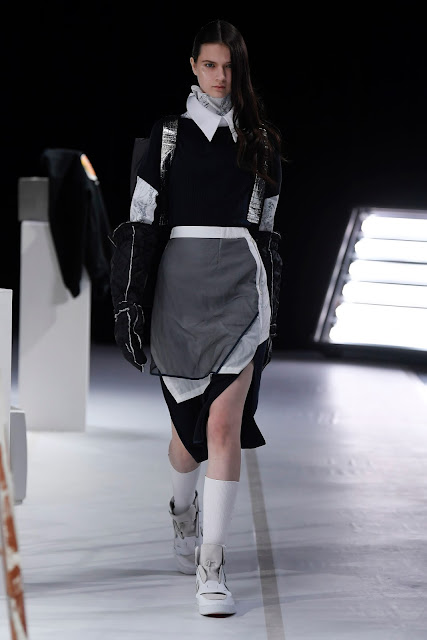Balmung. Spring 2020 RTW - Tokyo Fashion Week.
(Images from the designer and the public domain. Credited to the
photographer/company where applicable: WWD )
Mix and match styles aren't easily duplicated, particularly for the runway. More so when a brand is trying to implement a concept of interfused styles, in anticipation of being bought by the buyers attending fashion weeks. A smart designer will skillfully mix other styles to complement matching attributes. With fashion slowing down, which is not from any environmental cue, but more so economical. The Thrift styles are starting to take center point, as the backlogged looks ala of the last 10 years of the socioeconomiclly enlightened attempt at chasing trends are now petering out, what is replacing the past looks is a rawer broken down style. Whilst at the same time a desire to wear the exclusivity of designer labels, which in turn can be attached to the second hand (or third hand) looks. The individual will reign, as far as fashion is concerned, to which a new benchmark is becoming established, yet this is no way attributed by a market force. Rather, as spending power deceases across all markets, creativity is rising as the new motivation. Brands globally are scrambling to try and accommodate for this newer dynamic.
The Japanese brand Balmung created by Hachi, a young designer who launched his label in 2012, has set a decisive look for his Tokyo fashion week showing. Achieving the quintessential styles of mixing aspects of fine tailoring into Thrift or second hand shop styles. Breaking down the fitted styles on offering in balance with oversizes, layering and setting a defined look without it looking overly stuffy and clumped up. Which can occur with synthetic materials, depending on the configuration, especially when fitted onto the models. Hachi has been able to offset this, by adding a more artistic impression to the collection, such as the enlarged padded industrial gloves. This is undoubtedly has the designer infusing urban and monolithic cityscapes as a backdrop, in similar to the English designer Samuel Ross's A-Cold-Wall's broken urban dream or half built buildings, failed architecture and economic collpase. I like this, because in a conceptual sense, it reflects an array of interesting aesthetics. Rather than a negative when structure decays or is remodeled by necessity, it establishes a positive of something new evolving. The same can be said about fahion.
Hachi's color palette is mostly urban based. Construction inspired via muted tones of crushed whites and silver seen as building insulation, grays, white and blacks with inserts of dulled blues. An overall impressive collection for Balmung, who is based solely in Japan. A brand to watch.









Comments
Post a Comment